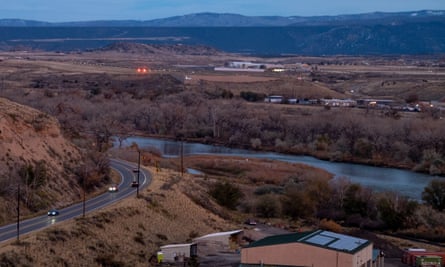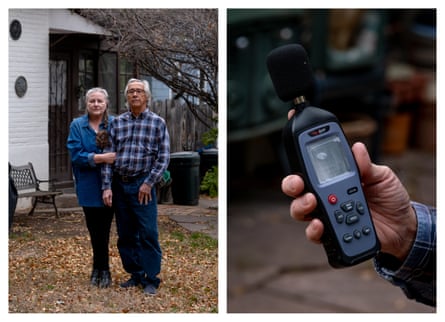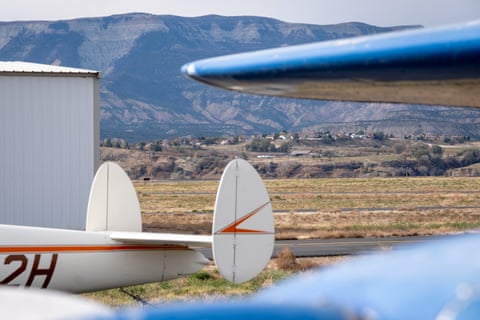It was just before noon on New Year’s Day when PJ Breslin reached her limit. As she angrily typed out a letter to the editor of the local newspaper, the roar of yet another jet aircraft drowned out her thoughts and rattled the windows of her home office.
“It’s insane to even contemplate that many private jets flying into one small location!” wrote Breslin, who has lived in the western Colorado town of Rifle for more than 25 years. “Jets owned by the wealthy, entitled, third-home owners and fake environmentalist celebrities, who have zero idea of their impact on the valley and the planet, much less their neighbors. Nor do they care.”
Private-jet traffic at the Rifle Garfield county airport, a public-use airport located three hours west of Denver, has increased by nearly 73% over the last five years, according to a data analysis conducted by the Guardian. The boom is part of a national trend, partially driven by wealthy travelers ditching commercial flights for private ones in hopes of dodging Covid restrictions, airport crowds and travel delays.
But the majority of people flying into Rifle aren’t staying. Instead, travelers quickly jet off to nearby mountain resort destinations such as Aspen or Vail in private rental cars, helicopters and limousines.

Brian Condie, the airport manager of nearly 21 years who also sits on the Rifle city council as the city’s mayor pro-tem, said he doesn’t mind that travelers don’t stay in the city of Rifle, as long as the airport is bringing in money. “It’s still an economic generator for Garfield county.”
But residents such as Breslin said they aren’t seeing direct economic benefits. Instead, she feels that the working-class people of Rifle – who can’t afford to charter a private jet – are subsidizing the lavish lifestyles of the wealthy while bearing the brunt of the noise and environmental impacts.
The dynamic, which is playing out across Colorado and the country, has been the focus of much of Dr Amber Woodburn McNair’s research. She’s an assistant professor of city and regional planning at Ohio State University and an affiliate at OSU’s Center for Aviation Studies. Tensions are heightened by the fact that much of the decision-making power related to airports lies in the hands of the US Department of Transportation’s Federal Aviation Administration – and a leading priority is keeping the skies open for business.
“The default position from the FAA is to try to accommodate – safely – as many operations and as much aviation growth [as] the market is dictating,” said Woodburn McNair.
This, she said, brings up environmental justice concerns.
“Who is being asked to bear the noise, bear the air quality, bear the traffic impacts there may be, bear the contribution to climate change,” she added. “Whose community is being asked to bear all of that?”
An environmental nightmare
When the Rifle airport opened in 1925, it was primarily used by farmers crop-dusting their nearby fields. Today, the airport has a very different clientele. To fly in or out of the airport, a flier must book a private charter flight, which can cost between $10,000 and $47,000 round-trip. Or they must own or lease their own aircraft, the cost of which can vary wildly; a small hobby plane can cost about $15,000 while the bill for a private jet can run into the tens of millions.
Its popularity among pilots and high-end travelers is due to a few reasons. The runway is regarded by pilots as being safer than the nearby Aspen/Pitkin county airport, and there are also no commercial security requirements or noise restrictions. General aviation traffic into Aspen and Eagle is often diverted to Rifle on high-traffic days or during poor weather events.
And unlike Aspen, Rifle has no flight curfews, meaning passengers can fly in or out at any hour, day or night.
Under the current rules, yearly operations at the Rifle airport are permitted to more than double, according to Condie. The airport is developing 69 more acres – which has attracted the attention of private equity firms looking to buy up airplane hangars as real estate investments.

Jeff Posey, the CEO of Genesis Energy Ventures, a private equity firm, and owner of Rifle Aviation LLC, built two hangars at the Rifle airport last year for $3.6m to capture spillover traffic from Aspen and Vail airports, and to keep up with the growing demand for hangars across the country. He stores two of his own jets in his hangar at the Rifle airport, and also rents out the space – which includes a private pilot’s lounge, to other fliers for a daily fee.
“Our hangar doubled in price in less than a year because you just can’t find hangars,” said Posey, whose business is registered using the address of a multimillion-dollar horse ranch in the nearby town of Basalt.
Posey has been approved to open a helicopter charter service at the airport that will shuttle people landing in Rifle to Aspen. There are also talks of opening a flight school or accepting commercial flights – both of which would increase traffic and likely noise complaints.
“It’s an exciting time for Rifle, for the growth of the area,” Posey, who lives in Aspen, said. “There’s going to be people complaining about the traffic. I get that. I do. But that’s just sort of part of this.”
Other hangar operators at Rifle airport include two real-estate developers, two attorneys, and a natural resource consultant – the majority of whom operate out of Aspen.
“The people who are buying and storing jets in Rifle aren’t the same people living here. That’s for sure,” said Garrick Frontella, a property manager in Rifle who sits on the city’s improvement team advisory board. He’d like to see the city receive some sort of compensation for the impact the airport is having on residents’ quality of life.
“There should be something, a tax or a fee,” he said. “We certainly aren’t seeing any benefit.”
A growing body of research shows extended exposure to aviation noise can lead to increased stress, cognitive disruption in children, sleep interference and higher risks of heart disease – all of which can take years off one’s life. The US Environmental Protection Agency was researching the health impacts of noise pollution up until 40 years ago, when the office in charge was defunded during President Ronald Reagan’s administration.
For Breslin, the sound of jets drowns out the television and makes it hard to think straight. She has trouble sleeping, often waking up in the middle of the night to her nightstand trembling as a jet rumbles above. In March, she purchased a $100 decibel meter to try to prove that the noise levels were exceeding the FAA’s limit, which is an average of 65 decibels over 24 hours. She frequently records noise levels reaching above 90 decibels, she said.
Breslin said the expanding airport has been the tipping point in what she describes as a “worsening environmental nightmare”.

She and her husband moved to Rifle in 1997 from Glenwood Springs, another bedroom community of Aspen. They opened a small business which helps homeowners install alternative energy systems such as solar panels and water filters that remove environmental toxins.
In recent years, they’ve been vocal about other environmental concerns in the area, speaking at public meetings and writing letters to elected officials. Their home is by the railroad, which was recently approved to start hauling crude oil, and the town, which is a hub for oil and gas operations, is nestled alongside the heavily traveled I-70 highway corridor. But they said nothing was worse than the sound of jets barrelling above their house at all hours of the night.
Condie, the airport manager, lives in town and frequently has aircraft flying over his home. He says the sound doesn’t bother him. “All I hear is money,” he joked, before pointing to what he sees as the economic benefits. The Rifle airport was estimated to support 277 jobs and $40.95m in business revenues, according to the state’s 2020 airport economic impact report. The analysis is partially based on data collected and reported by Condie and other airport staff.
“Is it money in residents’ pockets? No. But if there is a wildfire in the valley, those planes come from here,” said Condie. “So everyone in Rifle benefits.”
‘We don’t have any recourse’
Even before the pandemic, communities across Colorado – and the country – have been pushing for local governments and the FAA to institute more regulations on airport activities to limit noise, air pollution and lead exposure. But many local efforts have stalled because the FAA views efforts to regulate air traffic at the local level as being antithetical to its mission.
“You can’t restrict the airport,” John Bauer, the FAA manager of the north-west mountain region, said during an Aspen public meeting in February. “You can’t say, ‘Well, we’re gonna limit growth to X. You can’t say, ‘We don’t want this particular aircraft but we want this particular one.’”
Federal regulation encourages average noise levels at local airports to be measured approximately every 10 years. But monitoring is often scant, according to Woodburn McNair, or nonexistent as is the case in Rifle. (There has never been a noise study conducted at the Rifle airport, according to Condie.) The FAA recently sought public input on its noise policies, and is exploring whether it should take community annoyance and health impacts affiliated with aviation noise into account when setting limits.
In the meantime, local residents say they don’t have much recourse. They can call the airport to complain – or submit a formal complaint to the FAA, which often reroutes complaints back to airport managers. Once, Rifle residents were able to bring complaints to an airport authority, but that was dissolved in 1999. Now, all day-to-day operations are managed by Condie.

Meanwhile, a potential expansion of the runway at Aspen’s airport could lead to even more flight traffic in Rifle. For years, Aspen’s 12-person airport advisory board has debated whether to expand its runway to allow bigger planes to land – a move required by the FAA to continue receiving federal funding. The discussion has brought fierce pushback from some Aspen residents who don’t want to see more visitors and increasing noise and air pollution in their backyards.
Amory Lovins, a world-renowned physicist and president of the non-profit Aspen Fly Right, which is opposing the expansion, told the Guardian that the expansion will disrupt local efforts to “retain community character and quality of life” in the wealthy mountain town where the average home price is $2.9m. One solution, Lovins proposes, would be to divert more of Aspen’s non-commercial traffic to Rifle. He’s sympathetic to residents like Breslin who already bear the brunt of Aspen’s multimillion-dollar tourist economy. But given Rifle’s capacity for growth and its safer runway, he sees it as the lesser of two evils. “It’s going to bring them a lot of economic opportunities,” he said. “That’s very attractive.”
Breslin said that’s just another example of Aspen “throwing away their trash” in Rifle.
“We are the sacrifice zone in this valley,” Breslin said. “We always have been.”
